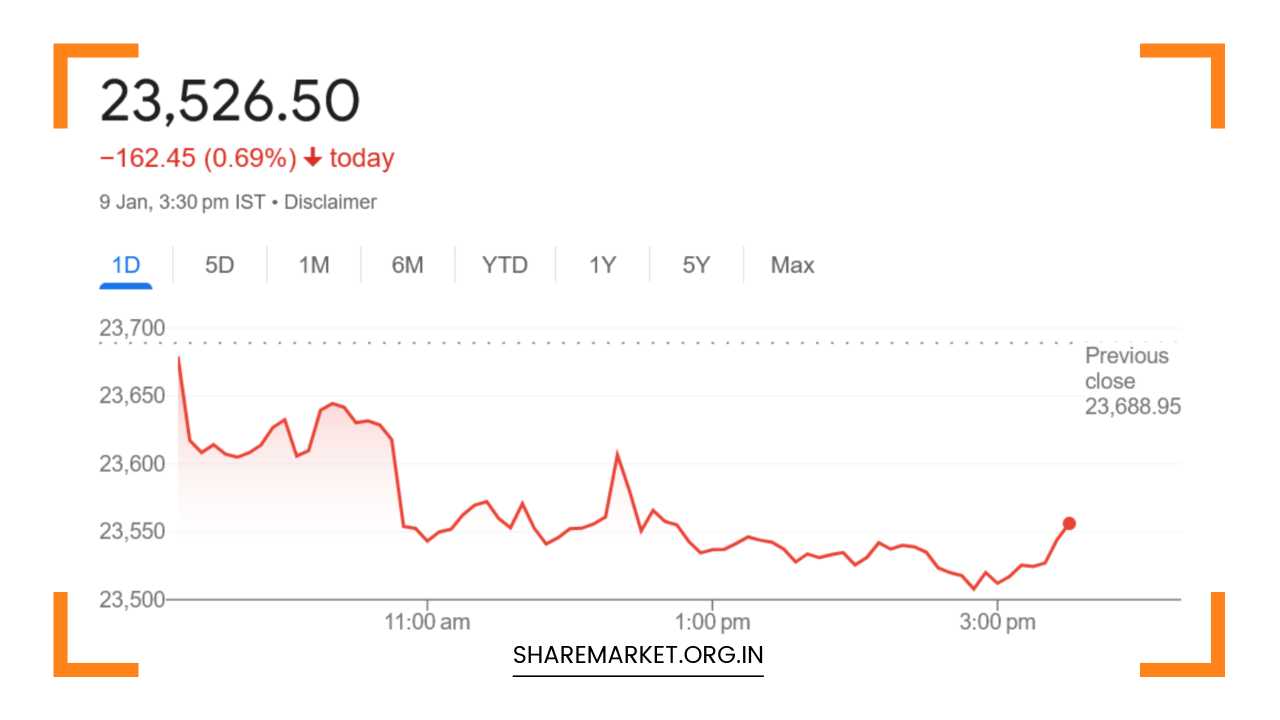Sensex Down 528 Points, Nifty at 23,526; Tomorrow Nifty Prediction

Tomorrow Nifty Prediction
Sensex and Nifty End Lower on January 9: What Lies Ahead for January 10
On January 9, Indian stock markets closed with notable declines as both the Sensex and Nifty finished the day in the red.
The broader market faced considerable selling pressure, and most sectors, except for FMCG, ended the session lower.
The Nifty closed below the crucial 23,550 mark, while the Sensex dropped by over 500 points. The performance on the day reflected broader concerns, including weak global cues, profit booking, and sectoral underperformance.
Here’s a detailed look at the day’s performance, sectoral breakdown, and potential market movements on January 10.
Market Overview on January 9
The Sensex closed at 77,620.21, down 528.28 points, or 0.68%. The Nifty finished at 23,526.50, losing 162.45 points, or 0.69%.
The day was marked by a significant breadth in the market, with 2,610 stocks declining, compared to just 1,175 stocks advancing and 109 stocks unchanged.
This broad-based weakness signaled a risk-off sentiment among investors, with most sectors facing selling pressure.
Among the biggest losers on the Nifty were Shriram Finance, ONGC, Tata Steel, Coal India, and BPCL.
These stocks were down significantly due to a mix of global and domestic factors affecting their respective sectors.
On the other hand, HUL, Britannia Industries, Nestle India, M&M, and Bajaj Auto emerged as the day’s few bright spots, managing to post gains despite the overall market weakness.
Sectoral Performance: FMCG Stands Out
The sectoral performance was largely negative, with all major indices except FMCG closing in the red. Capital Goods, IT, Metal, Oil & Gas, PSU Bank, Power, and Realty sectors faced sharp declines, most of them in the range of 1-2%.
- Capital Goods and IT stocks were hit by concerns over global economic growth, particularly in key markets like the US and Europe. Companies in these sectors are often sensitive to changes in economic cycles, and the uncertainty surrounding inflation and interest rates continues to weigh on their earnings outlooks.
- Metal and Oil & Gas stocks faced downward pressure as global commodity prices softened and concerns over China’s economic recovery resurfaced, which could dampen demand for industrial metals and energy products.
- The PSU Bank and Power sectors, which had recently seen some buying interest, were also caught in the broader market sell-off. The Realty sector, which had been performing well in the past months, came under pressure due to fears of rising interest rates, which could dampen housing demand.
The only sector that bucked the trend was FMCG, which benefitted from defensive buying. Stocks such as HUL, Britannia, and Nestle India saw a rise as investors sought refuge in defensive, stable growth stocks amid heightened market volatility.
Broader Market Performance: Midcap and Smallcap Indices
The BSE Midcap and Smallcap indices mirrored the weakness in the frontline indices, both closing down by 1-1%.
This widespread weakness across market segments indicates a lack of risk appetite among investors. Small-cap and mid-cap stocks, which tend to be more volatile, are particularly sensitive to broader market sentiment, and the sell-off on January 9 indicates that investors are preferring to stay cautious.
Technical Analysis: Nifty’s Crucial Support Levels
From a technical standpoint, Nifty closed near its critical support level at 23,500. The index formed a bearish candlestick pattern below its 200-day Exponential Moving Average (EMA), signaling a continuation of the downtrend.
The 200-day EMA is often considered a key long-term indicator, and a sustained move below this level suggests a bearish market sentiment.
- Support Levels: The 23,500 level is the immediate support for Nifty. If Nifty breaches this level, the next support zone comes around 23,260, which corresponds to a previous swing low. A breakdown below this could lead to further weakness and potentially a test of 23,000, a psychologically significant level.
- Resistance Levels: On the upside, 23,800-23,900 remains a significant resistance zone. For any upside momentum to gather steam, Nifty will need to decisively break above this range. Only then will the market likely enter a consolidation phase, which could eventually pave the way for a fresh uptrend.
Sentiment and Market Prediction: Caution Prevails
Aditya Gaggar, Director at Progressive Shares, noted that the market session was a challenging one, as selling pressure pushed the Nifty to its lowest point of the previous session.
He pointed out that almost every sector, except for FMCG, closed in the red, with the Realty and Energy sectors performing the worst.
According to Gaggar, if the market cannot hold the critical support levels, the trend could remain bearish, with further downside likely.
On the other hand, Vatsal Bhuva, Analyst at LKP Securities, emphasized that the formation of a bearish candlestick pattern below the 200-day EMA reflects the prevailing sense of caution in the market.
He believes that if Nifty breaks below the 23,500 support level, the market may see a sell-on-the-bounce strategy take hold, leading to further declines.
However, if Nifty manages to stay above 23,500, a phase of consolidation could follow, as traders look for more clarity on the global and domestic economic outlooks.
Key Levels to Watch for January 10
As we move into January 10, the immediate focus will be on whether Nifty can hold the 23,500 support level.
A breakdown below this level would be a bearish signal, suggesting further downside. On the other hand, if the index manages to consolidate around 23,500 and attempt a rally, it could face resistance at the 23,800-23,900 range.
Traders are advised to closely monitor these levels for signs of either a continuation of the downtrend or a potential reversal.
Given the current market conditions, caution remains the key word for traders and investors, as volatility is likely to continue in the short term.
Final Remarks: Stay Vigilant Amid Market Volatility
The Indian stock market is currently navigating through a period of uncertainty, marked by global economic concerns, sectoral underperformance, and cautious investor sentiment.
While the FMCG sector has managed to stand out, broader market weakness, especially in sectors like Realty, Metal, and IT, points to continued caution.
Traders should be mindful of key support and resistance levels, especially for Nifty, as these will likely dictate the short-term direction of the market.
Investors should also be prepared for potential volatility, making prudent risk management strategies essential in the current environment.

















